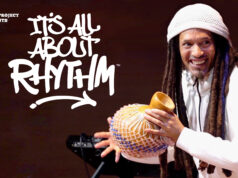Most people who play music are interested in collaborating with others, either starting a band or just jamming for fun. Yet for some it can be challenging to make that musical connection with another musician. Here are a few keys that will help you fit in to any musical collaboration.
Don’t lose the groove
One of the most important things in music is repetition. To establish a repeated structure for a piece gives everyone a framework within which to play. Take for example a structure of four bars that repeats and has added emphasis on the downbeat (beat 1). When I’m improvising over these four bars I play musical ideas that stray from the exact notes and rhythms of the repeated pattern. To show everyone that I know where I am I make sure to play a note on the downbeat with strong emphasis, just like everyone else. In this way I have plenty of space to improvise yet stay within the given form.
If I make a mistake in my playing, no matter how out of time or out of tune, or if I get lost, I make sure that I find my place in the structure and hit that strong downbeat. This approach can turn mistakes into musical ideas. If a mistake is made, repeat that same mistake and incorporate it into the piece.
Syncopate your rhythms
One of the best ways to add depth and excitement to a piece is to add syncopation, or the addition of beats between the strong beats. Try counting a piece as 1, 2, 3, 4, 1, 2, 3, 4 (repeating). Use a metronome to keep steady tempo. Now add the upbeats in between by saying 1 and 2 and 3 and 4 and (repeating)… Once you can do this then be selective. Try 1, 2 and 3, 4, 1, 2and 3, 4… Here’s another: 1, 2, 3 and 4 and 1, 2, 3 and 4 and… Learning to syncopate will give you a lot of new musical ideas.
Give each other space
Working with other musicians is all about understanding each other. One of the best ways to achieve understanding is to listen to each other and one of the best ways to do that is to give each other space to play. Try taking an 8-count (1, 2, 3, 4, 5, 6, 7, 8) but only playing beats 1 and 2. Essentially you will be counting in your head on beats 3-8. An easy way to practice this is to count out loud with your voice (repeat 1, 2, 3, 4, 5, 6, 7, 8) and clap only on beats 1 and 2. Try it! Now do a variation of this by playing different beats within the cycle. Try playing beats 1, 6 and 8. Again, count out loud with your voice (repeat 1, 2, 3, 4, 5, 6, 7, 8) and clap on beats 1, 6 and 8. Playing with space will give your fellow musicians an opportunity to fill in the space with their musical ideas.
Play in tune
Depending on your instrument playing in tune may be a great challenge or hardly an issue at all. That being said, you should always be aware of your intonation and try to tune yourself to the other musicians as closely as possible. When it comes to harmonizing and playing in unison, intonation is key. A great way to practice intonation is to play with an externally generated drone, such as an electronic tanpura (I use iTabla Pro) or sing while playing a pitched instrument like guitar or piano. This will help you to develop your ear and find ways to adjust your pitch to meet other musicians, even if they are slightly out of tune. For a challenge, check out these ear training exercises.
Thank you for joining me on this musical journey. I wish you fruitful collaborations ahead!













